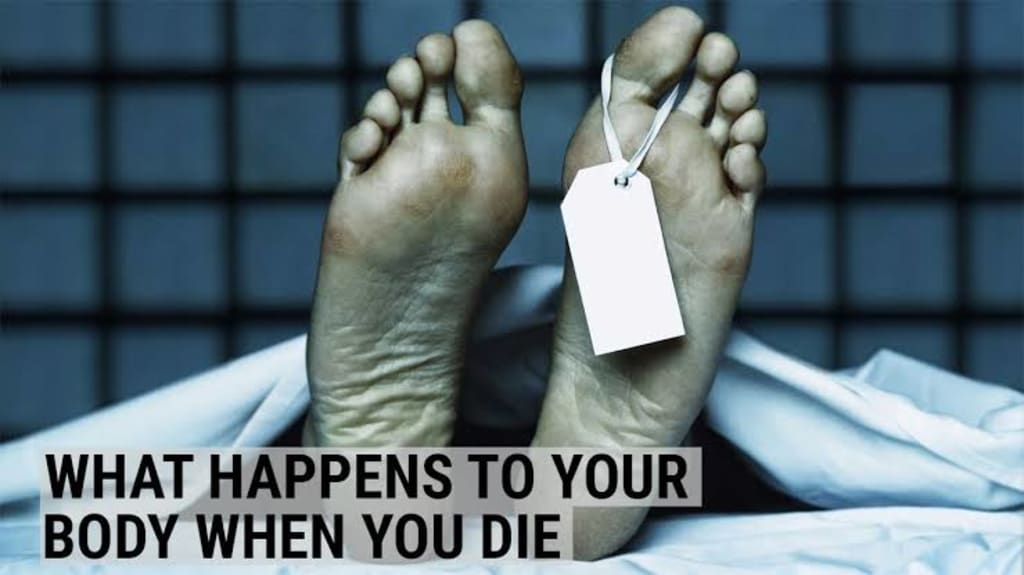What happens to the human body after death
Bizarre facts about human decomposition you need to know

Death is an inevitable part of the human experience, and it is something that has fascinated philosophers, scientists, and ordinary people alike for centuries. While the process of dying is often shrouded in mystery, what happens to the human body after death is a subject that has been extensively studied by medical professionals and scientists. In this essay, we will explore what happens to the human body after death, from the moment of death to the eventual decay of the body.
When a person dies, their body undergoes a series of changes that are collectively known as postmortem changes. The first of these changes is rigor mortis, which is the stiffening of the muscles in the body. Rigor mortis begins within hours of death and can last for up to 48 hours. During this time, the body becomes increasingly rigid, making it difficult to move or manipulate.
After rigor mortis sets in, the body begins to cool down. This process is known as algor mortis, and it can give medical professionals an idea of how long a person has been dead. The rate of cooling depends on a number of factors, including the temperature of the environment and the size of the body. In general, the body will lose approximately 1.5 degrees Fahrenheit per hour.
As the body cools down, it also begins to change in appearance. The skin becomes pale and waxy, and the eyes may appear sunken. This is due to the fact that blood is no longer circulating through the body, causing the capillaries to constrict. This process is known as livor mortis, and it can help medical professionals determine the position of the body at the time of death.
As time passes, the body will continue to undergo changes. Bacteria in the gut begin to break down the intestinal walls, causing them to leak. This process, known as autolysis, also causes the release of gases such as methane and hydrogen sulfide. These gases can cause the body to bloat, giving it a swollen appearance.
Eventually, the body will begin to decompose. This process is known as putrefaction, and it is caused by bacteria and other microorganisms that break down the tissues in the body. During this process, the body will give off a foul odor as the bacteria produce gases such as ammonia and cadaverine.
The rate of decomposition depends on a number of factors, including the temperature and humidity of the environment, as well as the presence of insects and other scavengers. In a warm and humid environment, decomposition can occur rapidly, while in a cool and dry environment, it may take much longer.
As the body continues to decompose, it will eventually reduce to a skeleton. This process can take anywhere from several months to several years, depending on the conditions. Once the bones are exposed to the elements, they may be scattered by scavengers or weathered away by erosion.
While the process of decomposition may seem gruesome, it plays an important role in the natural cycle of life. As the body breaks down, it releases nutrients back into the environment, which can be used by other organisms to grow and thrive.
In addition to the physical changes that occur after death, there are also psychological and emotional changes that can be experienced by those who are grieving. The experience of grief is different for everyone, but it often involves feelings of sadness, anger, and confusion. It is important for those who are grieving to seek support and guidance from friends, family members, or mental health professionals, as the process of mourning can be a difficult and painful one.
The physical changes that occur after death also have important implications for forensic investigations. Medical professionals and forensic scientists can use the postmortem changes in the body to estimate the time of death, as well as to gather other important information about the circumstances surrounding the death.
For example, the presence of certain chemicals in the body can indicate drug or alcohol use, while injuries to the body can provide clues about the cause of death. By carefully examining the body and conducting laboratory tests, forensic scientists can reconstruct the events that led to a person's death, and use this information to bring those responsible to justice.
Whether viewed as a natural process or a source of horror and fascination, the study of what happens to the human body after death is an important and endlessly fascinating field of inquiry. From the moment of death to the eventual decay of the body, the postmortem changes that occur provide insight into the mysteries of life and the natural world, and will continue to captivate and inspire us for generations to come.
For example, the use of human tissue and data in commercial applications, such as the development of new drugs or medical devices, raises important questions about ownership, intellectual property, and the exploitation of vulnerable populations.
To address these concerns, many countries have established ethical guidelines and regulations governing the use of human tissue and data in research. These guidelines typically require researchers to obtain informed consent from donors, to ensure that the data is used only for legitimate research purposes, and to protect the privacy and confidentiality of the donors.
Despite the many ethical challenges associated with the study of postmortem changes, it remains a vital and important area of inquiry. By studying the physical, psychological, and cultural changes that occur after death, we can deepen our understanding of the human experience and gain valuable insights into the mysteries of life and death.
In conclusion, the study of what happens to the human body after death is a complex and multifaceted field of inquiry that has important implications for medicine, forensics, culture, and ethics. From the moment of death to the eventual decay of the body, the postmortem changes that occur provide insight into the mysteries of life and the natural world, and continue to captivate and inspire us to this day.






Comments
There are no comments for this story
Be the first to respond and start the conversation.